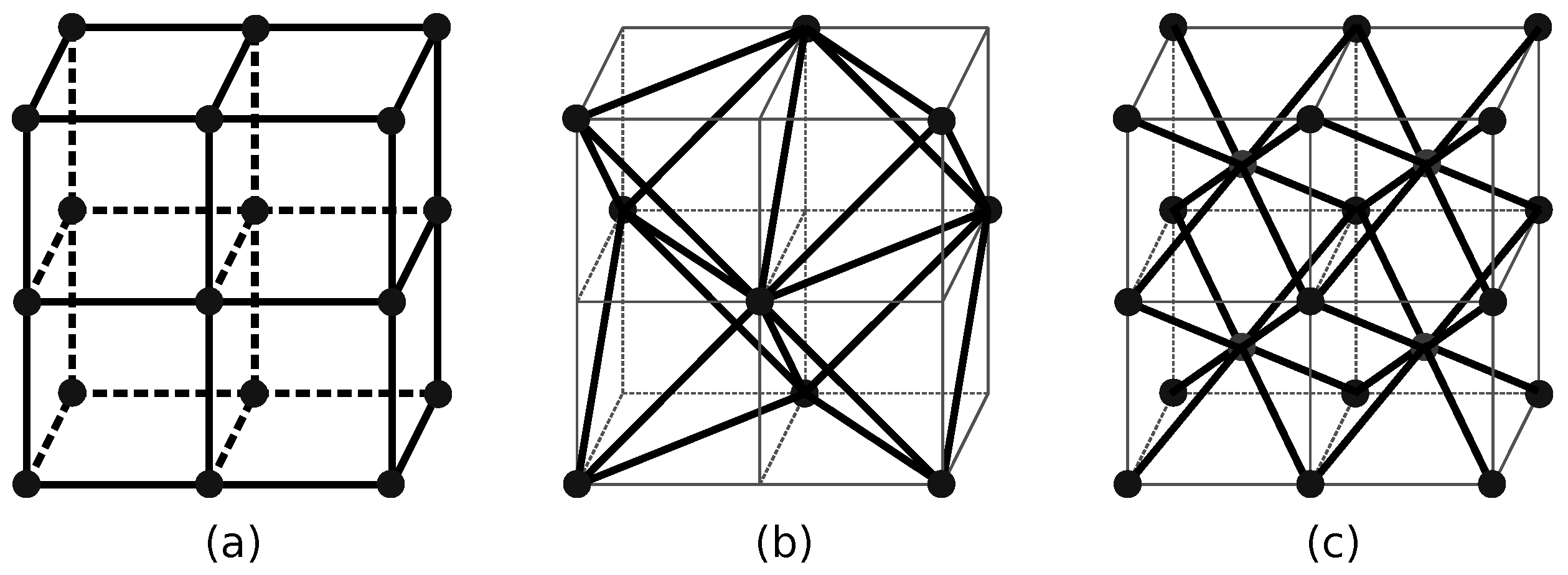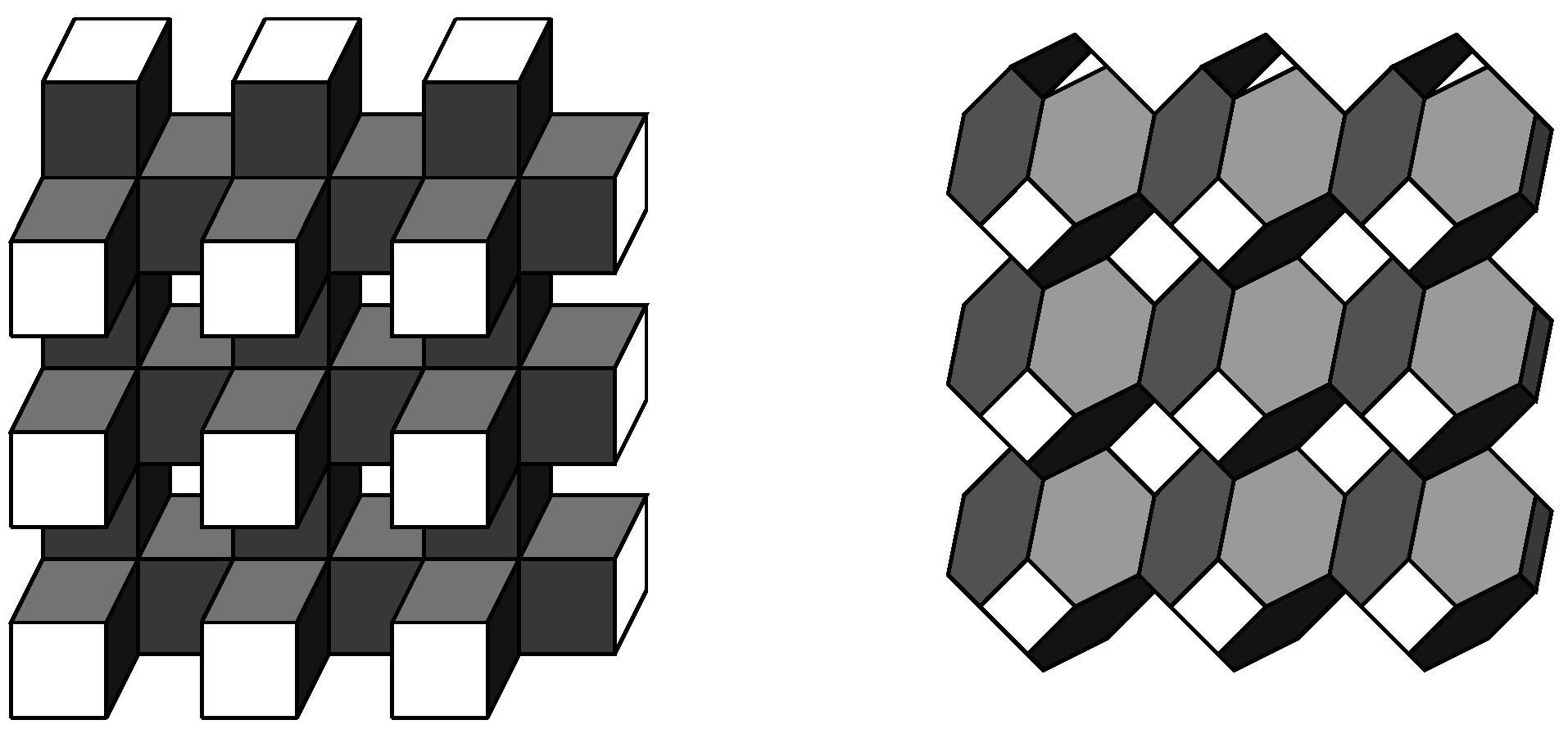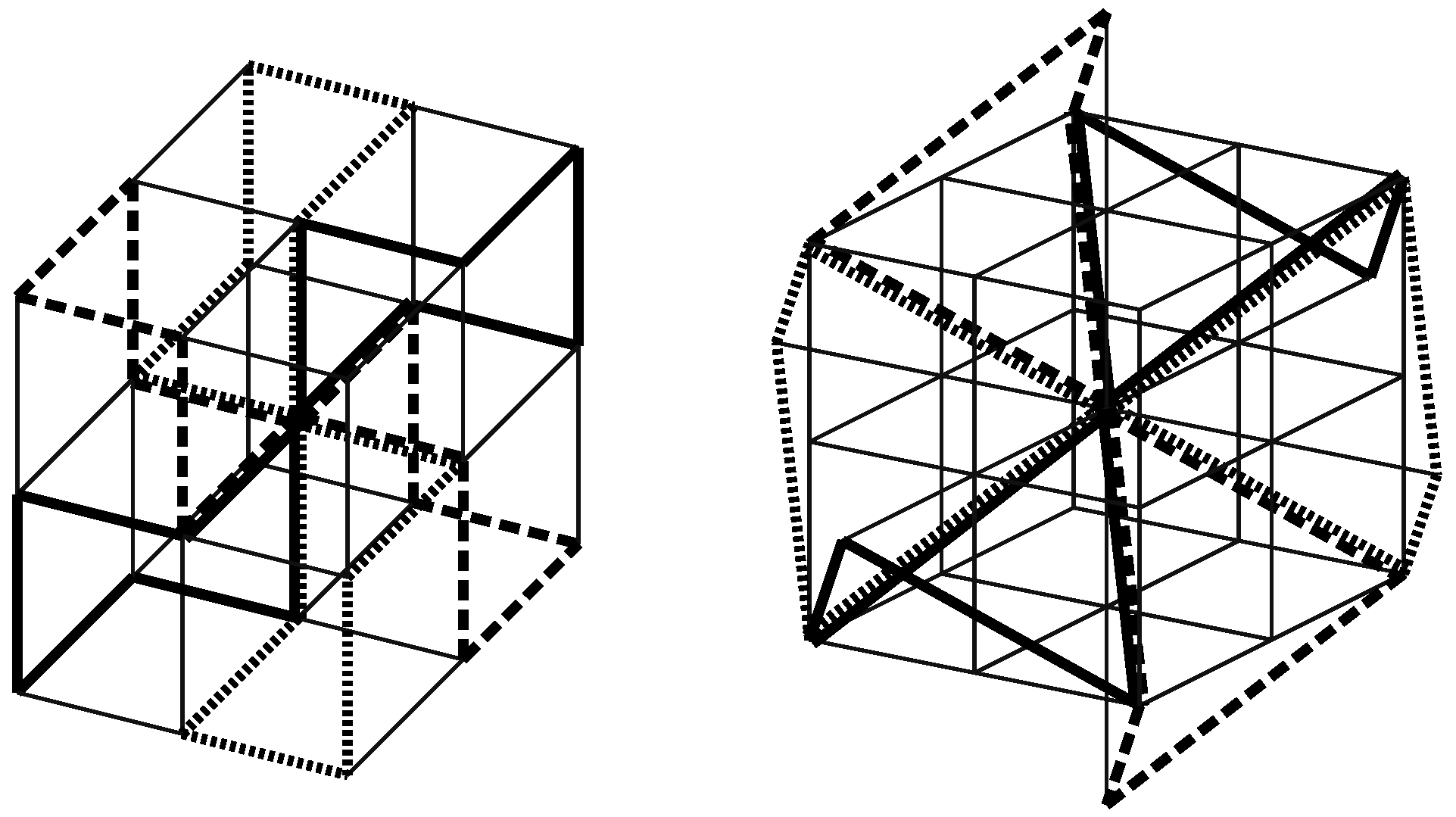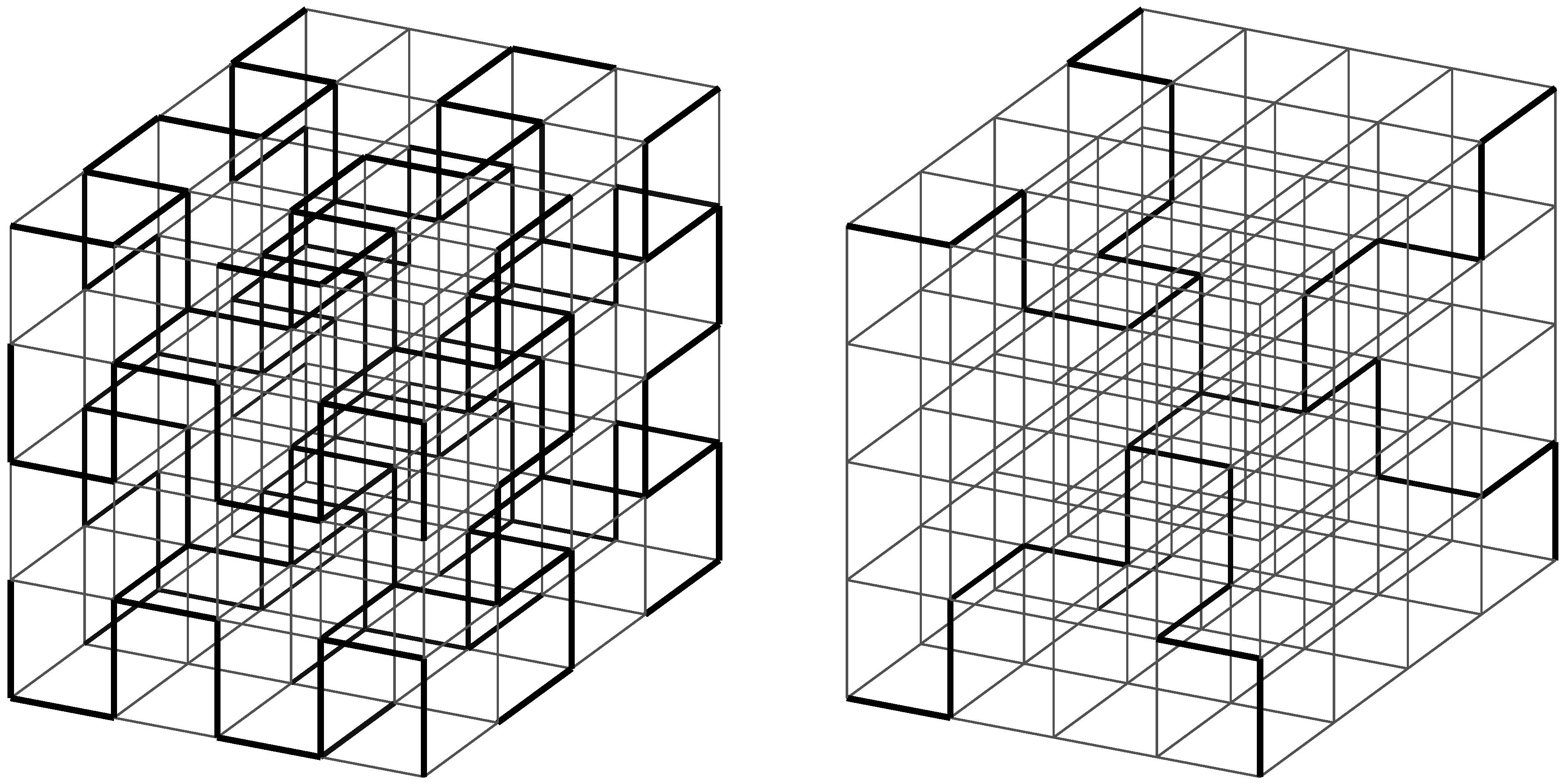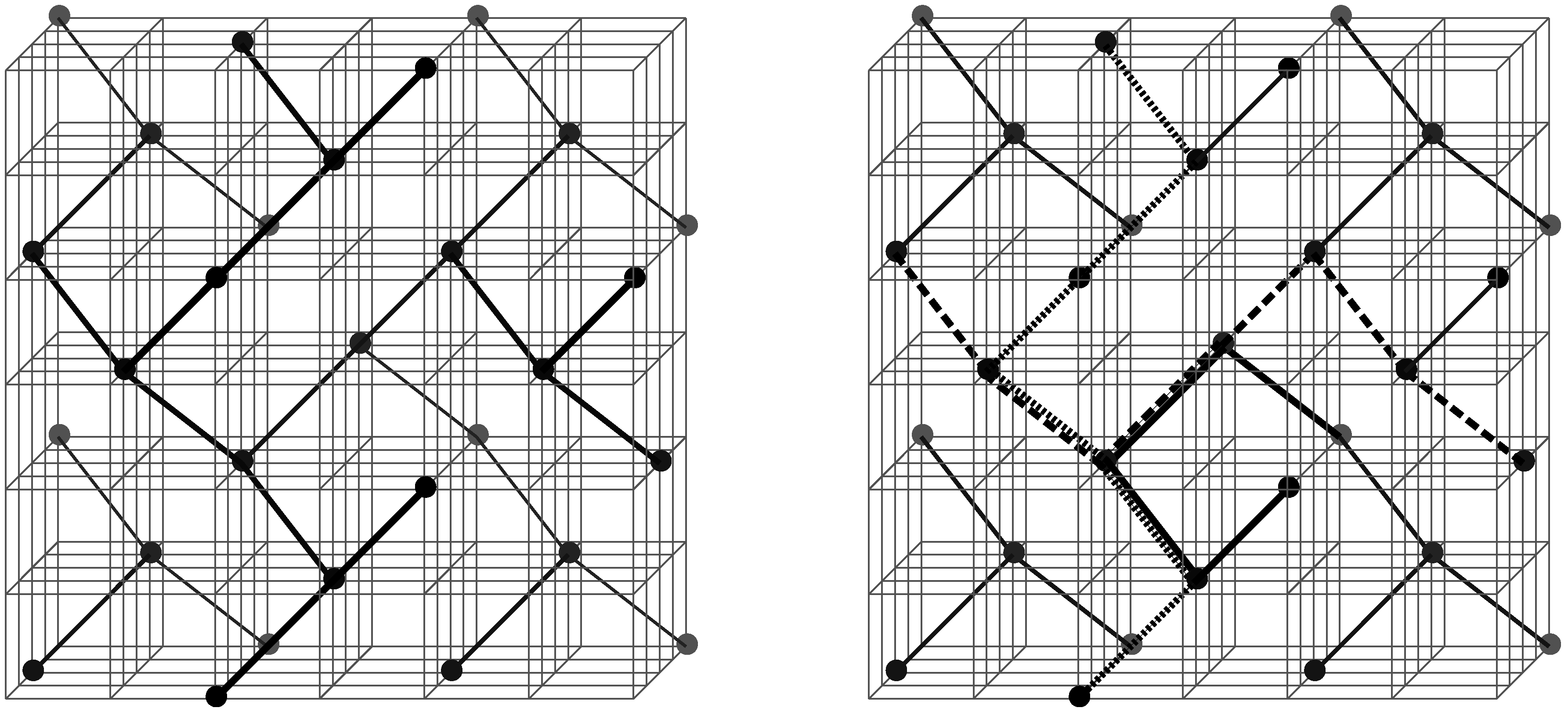Highly symmetric convex polyhedra have been studied for centuries. It is well-known that there are only five convex regular polyhedra and 13 Archimedean solids, which, together with the infinite families of prisms and antiprisms, are the only convex polyhedra whose faces are regular polygons and whose symmetry groups induce only one kind of vertex.
3.1. Definitions
For us, a polygon is an embedding to of a connected 2-regular graph; that is, of a cycle or of a two-sided infinite path. Polygons are explicitly allowed to be • skew (non-planar) and infinite, but we require the vertex set to be discrete.
A polyhedron is a (finite or infinite) collection of polygons (also called faces) with the properties that
the set of vertices is discrete,
the graph determined by all vertices and edges is connected,
every edge belongs to exactly two faces,
the vertex-figure at every vertex is a finite polygon. (The vertex-figure at a vertex v is the graph whose vertices are the neighbours of v, two of them joined by an edge whenever they are the neighbours of v in some face of the polyhedron.)
Convex polyhedra clearly satisfy the previous definition, as also do face-to-face tilings of the Euclidean plane (embedded in ) and many more interesting structures.
A symmetry of a polyhedron is an isometry of that preserves . The group of all isometries of is denoted .
Whenever there is a symmetry of that cyclically permutes the vertices of a face F, we say that has abstract rotations along F. Similarly, if there is a symmetry of that cyclically permutes the neighbours of a given vertex v, we say that has abstract rotations around v. An abstract reflection of is a symmetry that, for some triple of mutually incident vertex, edge, and face, it preserves two of the elements while moving the third.
When is a convex polyhedron, abstract rotations and abstract reflections are indeed rotations around some axes and reflections with respect to planes. However, if the faces are not planar, or they are not finite, then the abstract rotations about the faces are determined by the nature of the faces, and cannot be rotations about lines.
Some polygons admitting abstract rotations are shown in
Figure 3. An abstract rotation of a finite polygon that has all vertices on a plane may be either a geometric rotation or a rotatory reflection (composition of a rotation about a line
l and a reflection with respect to a plane perpendicular to
l). If the polygon is finite but skew (no plane contains all vertices), then an abstract rotation mapping a vertex to an adjacent vertex is necessarily a rotatory reflection. Some examples of finite polygons can be seen in the left side of
Figure 3. The abstract rotation that maps a vertex of a planar zigzag to a neighbouring vertex is either a twist (composition of a translation and a rotation with axis in the direction of the translation) or a glide reflection (composition of a translation and a reflection about the plane containing the direction of the translation). If the polygon is a helix then such an abstract rotation is necessarily a twist. A helix and a zigzag are shown in the right side of
Figure 3. In addition to the polygons mentioned above, polygons having all edges in the same line also admit abstract rotations, but they are not relevant for this work.
We say that a polyhedron is rotary whenever it admits all possible abstract rotations around all its faces and around all its vertices. A rotary polyhedron is regular if in addition it admits an abstract reflection, and chiral otherwise. The Platonic solids are the only convex polyhedra that are regular under this definition. Furthermore, there are no convex chiral polyhedra.
The definitions of polyhedron, regular, and chiral in this section are equivalent to those in [
10,
11,
14], and differ mildly only on the condition on the vertex-figure with those in [
7]. The above use of the term “chiral” is widely accepted in the community studying abstract polytopes and related topics; to avoid confusion, the reader should bear in mind that in chemistry this word is used to denote a substantially different property.
All faces of a regular or chiral polyhedron have the same number p of edges, and all vertices have the same degree q. The pair is called the Schläfli type (or just type) of the polytope. When studying rotary polyhedra, p is allowed to be ∞, but q must be finite to prevent the vertex set from being non-discrete.
A Petrie polygon of a polyhedron is a closed walk on the vertex and edge sets of , where any two consecutive edges—but not three—belong to the same face. The structure obtained from the vertex and edge set of , but considering the Petrie polygons as faces is often a polyhedron. When this occurs, it is called the Petrial of .
The Petrial of the cube is outlined in
Figure 4. The four faces are the hexagonal Petrie polygons in thick lines. Note that every edge belongs to precisely two such polygons.
3.2. Regular Polyhedra
In [
7], Grünbaum introduced the idea of polyhedron used in this and many other papers. There, he also described 47 regular polyhedra. The classification of the 48 regular polyhedra was achieved by Dress in [
8,
9]. A shorter proof of the completeness of the classification can be found in [
14]. Throughout, we shall use the names of the polyhedra given in [
14].
There are 18 finite regular polyhedra. They are the five Platonic solids, the four Kepler–Poinsot polyhedra, and the Petrials of the previous nine (see [
7,
15] for further details).
Six of the infinite regular polyhedra are in fact planar. Three of them are the regular tessellations of
by squares, equilateral triangles, and regular hexagons, denoted by
,
, and
, respectively. The remaining three are the Petrials
,
, and
of these tessellations.
Figure 5 shows two Petrie polygons of
, three of
, and three of
; all other Petrie polygons are translates of these.
The remaining 24 infinite regular polyhedra live properly in , and can be evenly divided into those that are blended (their automorphism groups permute the translates of some plane) and those that are pure (not blended).
Each blended polyhedron has a regular planar polyhedron as its image under the orthogonal projection to some plane Π, with the property that edges are mapped to edges and faces to faces. The orthogonal projection of to the line perpendicular to Π is either a line segment (the only regular polytope of rank 1) or a tessellation of by equal segments (the only regular polygon on the line), and we shall denote it by in either case. The polyhedron is then denoted by .
The vertices of the polyhedron
are contained in two parallel planes, and every edge joins a vertex in one plane to a vertex in the other. The polyhedron
is illustrated in
Figure 6a; the faces are skew quadrillaterals that project to the lower (or upper) plane into squares. The faces of
are helices over the faces of
. If two such faces share an edge, then one is obtained from the other by the reflection about a wall of the helix.
Figure 6c shows three faces of
, one in solid lines, one in dotted lines and one in dashed lines. One zigzag of
and one zigzag of
are shown in
Figure 6b,d, respectively.
To each of the 12 blended polyhedra, we may associate a real positive parameter
corresponding to the ratio between the lengths of an edge of
and a line segment of
. The parameter
determines the angle
between consecutive edges of a face. Assuming that
is the angle between two consecutive edges of a face of the planar polyhedron
, the parameter
satisfies that
when
is
, whereas
if
is
. The parameter
completely determines
up to similarity (see the polyhedra in Class 6 of [
7]).
Three of the pure polyhedra have finite planar faces and skew vertex-figures. Two of them were discovered by Petrie, and the remaining by Coxeter (see [
16]). The faces of
are squares of the cubic tessellation, while the faces of
and of
are hexagons in the lattice
fcu. Partial views of the polyhedra
and
are shown in
Figure 7.
Three infinite pure polyhedra have finite skew faces and planar vertex figures. The faces of the polyhedron consist of one Petrie polygon of each cube in the cubic tessellation, suitably chosen; this polyhedron is self-Petrial. The faces of the polyhedron are Petrie polygons of tetrahedra of the tiling of tetrahedra and octahedra; the faces of the polyhedron are Petrie polygons of octahedra of the same tiling. These two polyhedra are Petrials of each other.
The remaining six pure regular polyhedra have helical faces; three have skew vertex-figures and three planar vertex-figures. The polyhedra , , and are the Petrials of , , and , respectively, and therefore have skew vertex-figures. The faces of and are helices over triangles, whereas those of are helices over squares. The polyhedra and are Petrials of each other; the faces of the former are helices over triangles, and those of the latter are helices over squares. The polyhedron is self-Petrial, and its facets are helices over triangles.
In contrast to the blended polyhedra, the pure polyhedra are unique up to similarity. More details on their geometry can be found in [
7].
3.3. Chiral Polyhedra
In 2005, all chiral polyhedra in
were described by Schulte in [
10,
11]. Here, we briefly summarise that description. They are all infinite and pure, and can be classified into six infinite families.
The chiral polyhedra in the families , , and have finite skew faces and skew vertex-figures, whereas those in families , , and have helical faces and planar vertex-figures. The parameters take real values, not both 0, and a polyhedron with parameters or is similar to that with parameters or , respectively, for any . This makes it possible to consider the polyhedra in each family to be parametrised by only one real parameter or .
The parameters for polyhedra in the families , , and must be rational multiples of each other (or one of them 0), since otherwise the vertex set is not discrete. There is no such restriction for the parameters of polyhedra in the remaining three families. Each of the six families has two distinguished parameters for which the corresponding polyhedra are regular; the polyhedra determined by the remaining parameters are chiral.
The polyhedra in the family have type . Two of them, and (say), are combinatorially isomorphic if and only if for some , and they are congruent if and only if . The polyhedra and are the regular polyhedra and , respectively.
The polyhedra in the family have type . Two of them, and , are combinatorially isomorphic if and only if for some , and they are congruent if and only if . The polyhedra and are the regular polyhedra and , respectively. When c and d are relatively prime, with c odd and modulo 4, then the vertex-figure at every vertex is the union of two cycles, and thus in that case, is not a polyhedron.
The polyhedron is the dual of , meaning that its vertices are at the centres of the faces of , and each of its faces can be constructed around some vertex of . Hence, has type . Furthermore, and are combinatorially isomorphic if for some , and they are congruent if and only if . The polyhedra and are the regular polyhedra and , respectively.
If a polyhedron in one of the families , , and described above is not combinatorially isomorphic to any of the two regular members of the family, it is geometrically chiral and also chiral as a combinatorial structure.
The polyhedra in the family have type , and their faces are helices over triangles with the exception of . The regular instances of this family are (the tetrahedron) and . Any other member of the family is geometrically chiral but combinatorially isomorphic to . Two polyhedra and are similar when or for some ; and they are congruent if and only if or .
The polyhedra in the family also have type , but their faces are helices over squares with the exception of . The regular instances of this family are (the cube) and . Any other member of the family is geometrically chiral but combinatorially isomorphic to . Two polyhedra and are similar when or for some ; and they are congruent if and only if .
The two regular members of the family are (the octahedron) and . The remaining polyhedra of the family have type , and their faces are helices over triangles; they are all geometrically chiral but combinatorially isomorphic to the regular double cover of . Two polyhedra and are similar when or for some ; and they are congruent if and only if .
The continuous movement of the parameters of the polyhedra in the last three families can be understood as a continuous movement of the polyhedra , , and that preserves at all times the index 2 subgroup of the symmetry group generated by the abstract rotations.
More details about the chiral polyhedra described here can be found in [
10,
11,
17].
